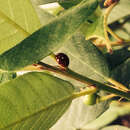pt-BR
nomes no trilho de navegação


Pukallarapra k'uslulu (Cycloneda sanguinea) nisqaqa huk k'uslulum, Antikunapim, Urin Awya Yalapi kawsaq. Suntu kurumamaqa qirisanpas ancha achka yura usakunatam mikhun.[1]
Pukallarapra k'uslulu (Cycloneda sanguinea) nisqaqa huk k'uslulum, Antikunapim, Urin Awya Yalapi kawsaq. Suntu kurumamaqa qirisanpas ancha achka yura usakunatam mikhun.
Cycloneda sanguinea, also known as the spotless lady beetle, is a widespread species of ladybird beetle in the Americas.
Cycloneda sanguinea is the most widespread ladybird beetle in Latin America,[1] with a distribution that ranges from the southern United States to Argentina,[2] and eastward to the Cayman Islands.[3] On the Galápagos Islands, it lives in sympatry with its sister species, Cycloneda galapagensis.[2]
Cycloneda sanguinea is a large ladybird beetle with red, unspotted elytra (wing covers). The color ranges from orange to deep red. The white and black marks on the head and pronotum are very distinctive, and they are also gender-specific. Females and males both have white spots on the black part, but the female has black in the center, continuing down into the face, while the male has a white cleft above the head and a white face. These ladybugs are very often found feeding on aphids on milkweeds, but also occur on a number of other plants.[3] Its pupae have the remarkable ability to "bite" potential predators using a device known as a "gin trap".[4]
Cycloneda sanguinea, also known as the spotless lady beetle, is a widespread species of ladybird beetle in the Americas.
Cycloneda sanguinea is een keversoort uit de familie lieveheersbeestjes (Coccinellidae). De wetenschappelijke naam van de soort is voor het eerst geldig gepubliceerd in 1763 door Linnaeus.[1]
Bronnen, noten en/of referentiesCycloneda sanguinea (joaninha-vermelha) é uma espécie amplamente difundida de joaninha nas Américas. Esta joaninha pode ser distinguida das outras devido à falta de manchas nos élitros
A joaninha-vermelha é o besouro joaninha mais difundido na América Latina,[1] com uma distribuição que varia do sul dos Estados Unidos até a Argentina,[2] e para o leste até as Ilhas Cayman.[3] Nas Ilhas Galápagos, vive em simpatria com sua espécie irmã, Cycloneda galapagensis.
A joaninha-vermelha é um grande besouro joaninha com élitros vermelhos e sem manchas (tampas das asas). A cor varia do laranja ao vermelho profundo. As marcas brancas e pretas na cabeça e no pronoto são muito distintas e também específicas de gênero. Fêmeas e machos têm manchas brancas na parte preta, mas a fêmea tem preto no centro, continuando para baixo no rosto, enquanto o macho tem uma fenda branca acima da cabeça e um rosto branco. Essas joaninhas são frequentemente encontradas se alimentando de pulgões em serralhas, mas também ocorrem em várias outras plantas.[3] Suas pupas têm a notável capacidade de "morder" potenciais predadores.[4]
Cycloneda sanguinea (joaninha-vermelha) é uma espécie amplamente difundida de joaninha nas Américas. Esta joaninha pode ser distinguida das outras devido à falta de manchas nos élitros